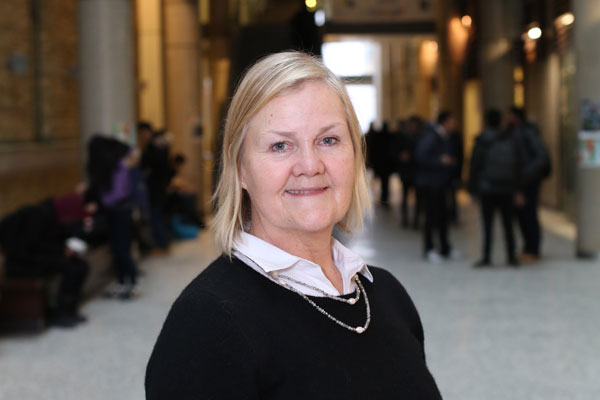
This story originally appeared on U of T Engineering News.
Professor Lesley Warren joined the Department of Civil Engineering and the Lassonde Institute of Mining on Jan. 1, 2016 as the Claudette MacKay-Lassonde Chair in Mineral Engineering.
Warren is an aqueous and microbial geochemist, who has pioneered the development of integrated approaches to address key questions linked to the roles microorganisms play in geochemical cycling, with a significant focus on water quality management in mining contexts. She has an internationally recognized track record of resource sector-based integrated geochemical and microbiological investigation, and has partnered with numerous energy and mining industry leaders. She serves on the Canadian Mining Industry Research Organization (CAMIRO) Expert Geochemistry panel and Syncrude Canada’s Reclamation and End Pit Lake Science Advisory Boards.
What excites you about your research?
What’s fun, exciting, and challenging about what I do is that my research group and I are usually the first people to do it. I’ve always been interested in solving problems, and I’m quite comfortable moving between disciplines. Environmental scientists tend to be creative about applying technologies from other disciplines to our field. We adopt emerging techniques about bacteria that have been developed for public health, and we apply these latest molecular techniques to environmental bacterial research—whether it’s in a mine tailings pond or a lake in Algonquin Park. The most exciting part is how we can use this information to create practical tools. What’s come out of every research project we’ve worked on is the knowledge that bacteria are present in every context and that they’re doing things that are important to water quality, but that we don’t yet understand.
You’re an environmental scientist. How will you fit into the Faculty of Applied Science and Engineering?
I’m a geochemist by training, which is part of earth science. If we want to understand what goes on in waters and river, we have to understand the interactions of our soils and rocks with that water because they’re all reactive. My research is about fundamental discoveries, which I think is what applied science is all about. In my research, we don’t know very much about the things we need to know to expand the field. We don’t yet fully understand the role these largely undescribed bacteria play in water, and this limits our ability to develop biological tools for the mining industry. I want to understand the system, and I’ll bring together whatever suite of tools I need. Engineering in general is very practical and speaks to interdisciplinary collaboration. This is the ideal environment to work together to find solutions. My research group is on the fundamental discovery side, and now we look to engineering to develop the tools from these discoveries that can be applied to industry.
Why is green mining important to you?
I’ve always been interested in water, and over the years, it became very clear to me that I was most interested in researching dirty water and how to clean it. I think that’s because I love the outdoors, and like most Canadians, I feel a deep connection to the outdoors—we see our forests, lakes, and rivers as our heritage. Water is one of the grand challenges we face, and it’s increasingly evident that we need to do a much better job of stewarding this resource. Mining’s devastating effects on water haven’t been well appreciated. Some 70 percent of world’s mines are at risk of acid mine drainage, which is the number-one global mining pollution issue around the world—this acidic, metal-laden wastewater can really damage downstream water bodies. Every mining or resource extraction company uses water, and they produce a significant amount of dirty water. They need far better strategies for cleaning and treating that water before it’s discharged. Mining in Canada uses half of our renewable water supplies every year—that’s a significant amount of water that can be significantly degraded if it’s not treated properly. Mining companies are well aware of this, and the increasing number of sustainable mining initiatives is a testament to this.
For me, green mining is all about creating the best standard of wastewater treatment for the industry. Industry needs the tools to do a better job, and there is an enormous opportunity here for applied science. Industry has generally relied on chemical water treatment, and that sometimes works, but not always—sometimes isn’t good enough. We know that bacteria drive a lot of the processes that affect water quality, and that’s what I’m interested in.
What are you most looking forward to about your new position?
Being somewhere with mining as its core mission is thrilling. The Claudette MacKay Lassonde Chair position will help me formalize the key mining interests in my research program, and help me to build larger, more innovative collaborations with interdisciplinary members of the Lassonde Institute of Mining, the Department of Civil Engineering, and the wider engineering faculty and University of Toronto. From a personal research perspective, this is the first time I’m working within a faculty of engineering, and I look forward to discussing how my fundamental research can be developed and engineered into practical programs and solutions for industry.
Tell us something that we’d be surprised to learn about you.
My father was in the Royal Navy, so I grew up by the seas all around the world. I’ve always loved water and being in water—this is probably where my passion to study it comes from. I wanted to understand more about water and the outdoors. I learn better outdoors.